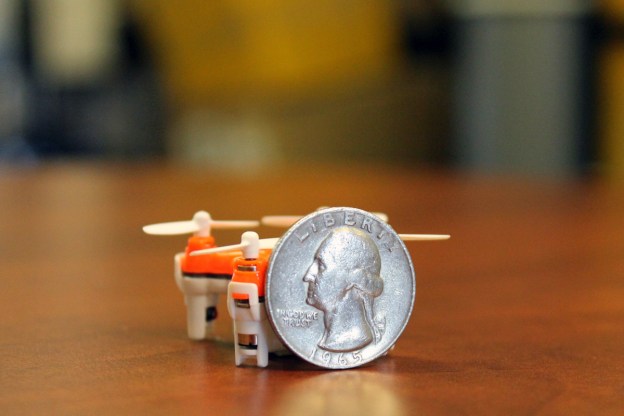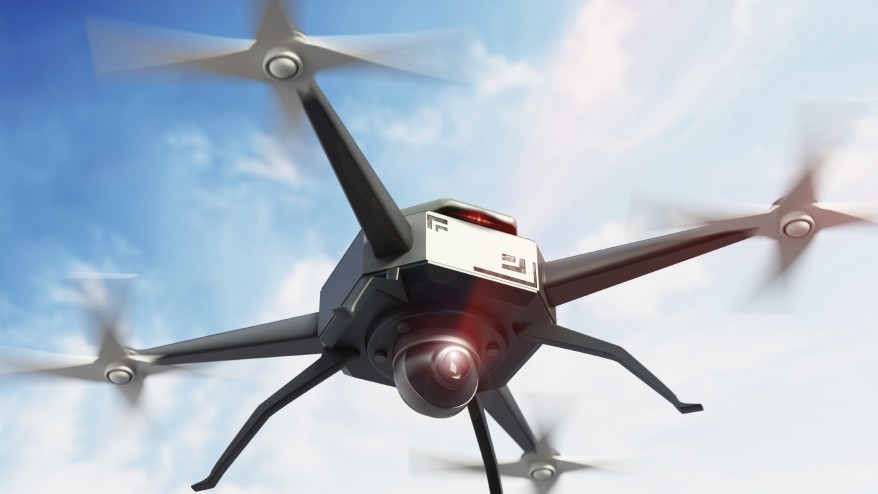by: Gary Mortimer • 16 August 2015
A rumour and purple tent was all it took for GeekWire’s Jacob Dement to claim a secret Amazon drone testing site.
There I was, air conditioner blasting in my Car2Go as I sat in front of a red gate on a gravel road in rural Snoqualmie, Wash. Multiple locals told me this was what I had come looking for: the entrance to Amazon’s secret drone testing site.
I wasn’t lucky enough to show up on a day when Amazon’s prototype delivery drone was being tested. But then I pulled up Google Maps to try to get a sense of where exactly I was.
And that’s when I saw it.
This satellite image, taken on a previous day, shows activity in the area beyond the gate. You can see a couple dark objects on the ground at either end of the image, what looks like a purple tent, a white van and some other vehicles — exactly where people in the area told me they’ve seen Amazon’s team set up.
Does it really matter if some Amazon employees are off multirotor flying somewhere?
We know they are!
Lets find some facts for Jacob, all thanks to published data from the FAA.
Long time sUAS News readers will be aware of our Drone Spotters collection of drone tail numbers from around the world, set up to monitor who was selling what to where. I notice Amazon registered its third official drone. N394PA appeared on the register just last Thursday.
We can learn some stuff from their naming, its a mark 24, so I think it’s fair to assume the 24th type of prototype and its serial number 14 so there are at least 14 mark 24’s out in the wild.
It joins N391PA and N392PA, serial numbers 6 and 8 respectively.
N393PA is not going to happen as it’s already allocated to an autogyro.
The questions I would ask is have they distributed other airframes to test simultaneously around the world and are Amazon just creating marketing footage in the USA?
Flying around a bit at the end of a track is hardly testing detect sense and avoid. Its not probing the platforms sensitivity to EMF. Its not testing a whole host of things.
Jacob, please do me a favour pop back and see if you can find a second site. One about 5km away. One that Amazon might be flying test deliveries to. That would be the sort of thing I would be testing to a track in the middle of nowhere.
Jacob also head off to Walmart and buy a scanner Unidenscanner
Then listen out on the local air traffic frequencies just in case the Amazon guys are doing the right thing and calling their position for VFR traffic in the local area.
It might also be worth dropping into Fall City Airport and finding out if any Amazon execs have flown in. They probably have a working relationship with the test team.
I would do it myself but its Sunday morning in South Africa and time to go out for a family breakfast. (some time passes) After breakfast I found the spot, skip to the bottom.
Here’s what Amazons Paul Misener, Vice President, Global Public Policy had to say last year in their FAA 333 exemption.
Our R&D operations will provide for a level of safety that far exceeds the level of safety required by FAA for hobbyists and manufacturers of model aircraft. The following operating procedures will apply during the R&D testing conducted under this exemption request:
- The sUAS will (i) have a maximum weight of less than 55 pounds; (ii) be rotor‐ powered via a battery source; and (iii) be U.S.‐registered and display marks in accordance with 14 C.F.R. Part 45, Subpart C.5
- Our sUAS R&D testing under this exemption will be conducted (i) within the visual line of sight of the operator and/or one or more observers; (ii) at less than 400 feet AGL; and (iii) within Class G airspace.
- The operations will be conducted in a confined area over isolated Amazon private property located a sufficient distance away from (i) any airport, heliport, seaplane base, spaceport or other location with aviation activities; (ii) any densely populated areas; and (iii) any military or U.S. government installations or airfields.6
- All operations will remain within the lateral and vertical boundaries of the operating area, taking into account all factors, including wind, gross weight and glide distances, that may affect the capability of the sUAS to remain within the airspace boundary; moreover, the integrity of the operating area will be reinforced by geo‐fencing,7 including the ceiling height of no more than 400 feet AGL.
- Our sUAS R&D testing under this exemption will be conducted (i) under the supervision of a designated pilot in command (PIC) who has final responsibility for the operation in accordance with 14 C.F.R. § 91.3 and either (A) holds a current FAA private pilot certificate issued under 14 C.F.R. Part 61, Subpart E, a higher FAA pilot certification, or a FAA‐recognized equivalent8 or (B) has completed FAA private pilot ground instruction and passed the FAA private pilot written examination or FAA‐recognized equivalent; and (ii) using only operators that have completed training on the normal, abnormal, and emergency procedures in specific details and demonstrated proficiency with the sUAS being operated.
- No operator or observer will engage in, nor may an operator or observer permit, any activity during a critical phase of flight which could distract any operator or observer from the performance of his/her duties or interfere in any way with the proper conduct of his/her duties.
- Operators will maintain the sUAS system in a condition for safe operation, and conduct a pre‐flight inspection prior to each flight so as to ensure that the sUAS, control station, data link equipment, payload, and support equipment are in a condition for safe operation and in a configuration appropriate for the purpose of the intended flight.
- The operators and observers will maintain two‐way communications with each other during all operations; if unable to maintain two‐way communications, or if any condition occurs that may otherwise cause the operation to be unsafe, the operator will immediately conclude the operation.
- Each sUAS will safely stop operating and return automatically to a specific location on Amazon’s private property if the communications link is lost.
- For each sUAS, the observer will have the ability to press a physical button, that will be within his/her reach at all times, that reduces power to the vehicle so as to force a controlled landing; both the hardware and communication for this safety system will be physically separate from the sUAS flight control systems.
- Testing operations will be conducted on private property, and only Amazon employees, contract personnel, and invitees will be invited to the operations area; security measures will be put in place to deter unauthorized access.
A gentle VR flight and I found where it is
amazonssecretsite
amazonssecretsite2
I guess distance is a relative, living as I do in Africa 45 minutes very often is the minimum you have to travel for more life. I have lived in places where an aeroplane was the only way to the shops.
With that in mind, this line…
So I grabbed a Car2Go in Seattle and made the 45 minute drive out into the middle of nowhere. It’s the kind of place where “No Trespassing” signs outnumber doorbells and people don’t seem fond of strangers wandering on to their front porches.
Then checking, its 6 minutes to the nearest African sounding joint, Sahara Pizza (tenuous I know) Raised a smile here. Also amusing the railway stations of startup and goldbar to the right of the title map. That’s why I made it so wide.
http://www.suasnews.com/2015/08/37836/amazons-secret-drone-test-site/
 Image Source: Axis Drones
Image Source: Axis Drones



